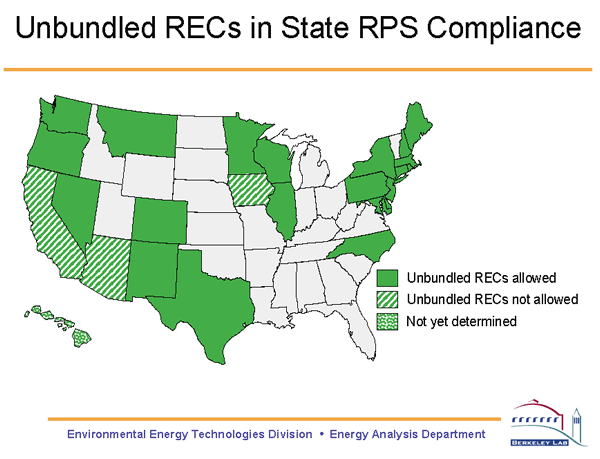 A new report was released by the U.S. Dept of Energy’s Lawrence Berkley National Laboratory (Berkley Lab) shows that renewable energy is being supported by a growing number of states. This is being done by the creation of renewable portfolio standards (RPS) which this report gives an overview of the experience with these new state-level policies. A RPS policy is one that requires retail electricity suppliers to procure a stated minimum quantity of eligible renewable energy.
A new report was released by the U.S. Dept of Energy’s Lawrence Berkley National Laboratory (Berkley Lab) shows that renewable energy is being supported by a growing number of states. This is being done by the creation of renewable portfolio standards (RPS) which this report gives an overview of the experience with these new state-level policies. A RPS policy is one that requires retail electricity suppliers to procure a stated minimum quantity of eligible renewable energy.
“State RPS policies require utilities to buy a certain amount of renewable energy, and these programs have emerged as one of the most important drivers of renewable energy deployment in the U.S.,” states Ryan Wiser, “But, as the popularity and importance of these RPS’s have increased, so too has the need to keep up with the design, early experience, and projected impacts of these programs. Our report is designed to meet that need.” Ryan Wiser is part of Berkeley Lab’s Environmental Energy Technologies Division (EETD) and was one of two primary authors for the report.
25 states and Washignton DC have RPS policies in effect and apply to nearly 50% of the total U.S. electricity load. In 2007 four new states have non-binding goals.
The reports other primary author and member of Berkley Lab’s EETD noted “Many of these policies have been established recently and each is designed differently, As a result, the experience has been decidedly mixed.”
Key findings of the study include:
- More than 50-percent of non-hydro renewable capacity additions in the U.S. from 1998 through 2007 occurred in states with RPS policies, and 93-percent of these additions came from wind power.
- Existing state RPS policies, if fully achieved, would require roughly 60 GW of new renewable capacity by 2025, equivalent to 15-percent of projected electricity demand growth.
- Solar set-asides in state RPS policies are becoming more common, and these policies have supported more than 165 MW of new solar capacity so far; a total of roughly 6,700 MW of solar capacity would be needed by 2025 to fully meet these set-asides.
- The early-year renewable energy purchase targets in the majority of state RPS policies have been fully or almost-fully achieved, with overall average compliance at 94-percent in 2006.
- Nonetheless, a number of states have struggled to meet even their early-year RPS targets, and many states have been reluctant to penalize non-compliance.
- Renewable energy certificate (REC) tracking systems continue to expand, and all but four states allow unbundled RECs to count towards RPS compliance.
- The cost of RPS policies varies by state, but in most states, these programs have, so far, increased electricity rates by one-percent or less; in several states, the renewable electricity required by RPS policies appears competitive with fossil generation
The market for renewable energy is rapidly changing and increasingly states are hoping to support this growth. “Given the major role that state RPS policies are playing, we hope that this report will help improve the next generation of these programs,” Wiser concluded.
The Office of Energy Efficiency and Renewable Energy and by the Office of Electricity Delivery and Energy Reliability of the U.S. Department of Energy funded Berkeley Lab’s contributions to this report.
Berkeley Lab islocated in Berkeley, California and is a U.S. Department of Energy national laboratory . It is managed by the University of California and conducts unclassified scientific research. You can visit their website at www.lbl.gov.